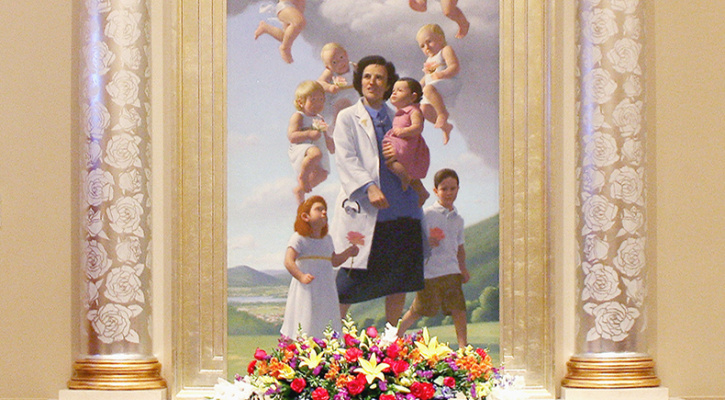Are Those Who Experience Same-Sex Attraction Prone to Abuse? by Dr. Jeff Mirus

When It’s Right to Indict the Democrats, by Dr. Michael Brown
March 4, 2019
CNA: Trump Joins Pro-Life Activists to Address CPAC
March 4, 2019
A group of marchers walk at the Pride parade in San Francisco, Sunday, June 25, 2017. (AP Photo/Jeff Chiu)
By Dr. Jeff Mirus, Catholic Culture, Mar 01, 2019
 I noticed on our Facebook page that there was a brief discussion of whether or not those who experience same-sex attraction are predisposed to sexual abuse. Without considering the distinction between abuse that is legal and abuse that is illegal, the answer is “yes” of course—just as the answer is “yes” for those who experience opposite-sex attraction. That is why God invented the virtue of chastity.
I noticed on our Facebook page that there was a brief discussion of whether or not those who experience same-sex attraction are predisposed to sexual abuse. Without considering the distinction between abuse that is legal and abuse that is illegal, the answer is “yes” of course—just as the answer is “yes” for those who experience opposite-sex attraction. That is why God invented the virtue of chastity.
I will return to this point, which is really the most important point, but only after we get back inside the law. In most of the contemporary West, there is an odd sort of legality which, at least for the most part, brands as forbidden only sexual congress in which one of the parties either has not given consent or is not capable of giving informed consent. In practice, this criminalizes rape and sexual relations with minors, while leaving every other violation of chastity outside the scope of the legal system. This is why, in Catholic discussions today, it is sexual relations with minors which we call “sexual abuse” or “clerical abuse”.
One more point must be clarified. When we ask whether those who experience same-sex attraction are predisposed to sexual abuse in this legal sense, we could be asking either of two questions. The first is whether each person with same-sex attraction is predisposed toward abuse. The second is whether a predisposition toward abuse (of children) exists in a significantly higher percentage of those having same-sex attraction as compared with those having opposite-sex attraction.
The answer to the first question is manifestly “no”. There are thousands of factors which go into the making of our particular desires, tendencies and temptations. Clearly, a person can be same-sex attracted without desiring to engage in sexual congress with boys under the age of consent. But just as clearly, the answer to the second question is “yes”. The evidence is overwhelming that—in comparison with heterosexual abuse of girls—the percentage of homosexuals who abuse boys is dramatically higher.
Evidence
How can I prove such a statement? I am sure there are statistics available somewhere on this question, but I am not going to consult them, because I would have no compelling reason to trust them. This sort of information is very difficult to compile from carefully controlled interviews or polls. But there are three kinds of evidence that are universally known which are strong enough to clinch the case.
Let us begin with the current situation among the clergy of the Catholic Church. There is now a mountain of evidence proving that precisely this sort of abuse—that is, sexual abuse of legal minors—is perpetrated in dazzlingly higher percentages by homosexuals, and this is true with remarkable uniformity in all the nations around the world that struggle with this problem. (As an aside, if we were to expand the age limit to include young men in their very late teens or early twenties, the results would be the same, which is not irrelevant, since the age of majority is somewhat arbitrary.)
We might also recall that St. Peter Damian, one of the Church’s most active reformers, faced the same problem among the clergy in the eleventh century. Moreover, once we start considering the historical record, we find that the very birthplace of what we call Western culture—ancient Greece—was plagued with a widely-approved set of sexual relationships between men and boys. This is where we get the term “pederasty”; it most frequently involved older men with teen-aged boys. It was an acknowledged cultural convention complete with initiation ceremonies.
This endemic cultural practice was probably the biggest single reason the Romans had such contempt for the Greeks, though such “relationships” were not completely unknown among the Romans either.
In speaking of the formal institution of such behavior, we should also look at the continuing efforts today to elevate man-boy sexual relations to an honored and accepted status, in which the relationship is argued to be beneficial to both. While this attitude is widespread in homosexual circles, it is given its classical public form by organizations such as NAMBLA, the North American Man/Boy Love Association (founded in 1978). According to Wikipedia, membership in NAMBLA has dwindled in recent years, but this is most likely because it is so much easier to engage in man-boy sex without public advocacy. Many members have simply joined online pedophile networks.
The point in this recital of evidence is that you will look in vain for any similarly widespread cultural and historical pattern of abuse involving older men and little girls. It is not a recurrent theme in Church history, and it has not been culturally advocated over time.
Yes, certainly such abuse does occur. There are a great many strange sexual attractions which present themselves to both men and women in our disordered state of Original Sin. Where such attractions are unchecked by the virtue of chastity, the corresponding abuse will occur. But I am not arguing that everyone who experiences same-sex attraction is predisposed to desire sex with minors and that nobody who experiences opposite-sex attraction is so inclined. I am simply pointing out the kind of obvious reality our culture is so keen at present to deny: Such a predisposition exists, at a much higher statistical level, among homosexuals.
Back to Chastity
For the Catholic, however, concern about the age of consent ought to be decidedly secondary to a far greater concern about the contempt in which Western culture holds the virtue of chastity. For no matter how we define sexual abuse, it is not a problem that can be contained and controlled by law and government. As with widespread destructive personal, social, economic or cultural failings in all societies, the law can serve only as a general guide to the worst offenses and as a means for punishing the worst offenders. While the law is one element in the formation of culture, good law cannot even exist without corresponding virtues in the community of lawmakers, as the degeneration of Western law regarding abortion so aptly demonstrates. In the absence of virtue, law must degenerate into either lamentable ineffectuality or perceived despotism.
But our contemporary contempt for chastity actually encourages widespread abuse of every kind. We are all sexual persons, for whom it is normal to have sexual desires. But we are also disordered, which means it is normal for our desires to stray toward illegitimate objects, at which point they become temptations. A successful human life consists largely in checking such temptations by reshaping our inclinations in accordance with a proper ordering of our nature. This requires a discernment of human nature which, while possible even at the natural level, is made for easier through Revelation, even while its mastery is made far easier through grace.
Contempt for chastity makes sexual abuse pandemic for the simple reason that, in matters of sexual temptation, it is precisely the virtue of chastity which provides the remedy. Extending beyond our personal struggles, chastity also becomes an important element in the glue that holds entire societies together, which enables men and women to form cohesive cultures oriented toward the good, and which empowers citizens to make virtuous laws while at the same time ensuring, in the vast majority of cases, that the virtues required for the common good need not be legally coerced.
There are many such virtues. But in our time, chastity ought to be fostered with a particular intensity. Until that happens, even bishops, priests and religious will be effectively powerless in the struggle against abuse.
________________________________
Jeffrey Mirus holds a Ph.D. in intellectual history from Princeton University. A co-founder of Christendom College, he also pioneered Catholic Internet services. He is the founder of Trinity Communications and CatholicCulture.org. See full bio.




